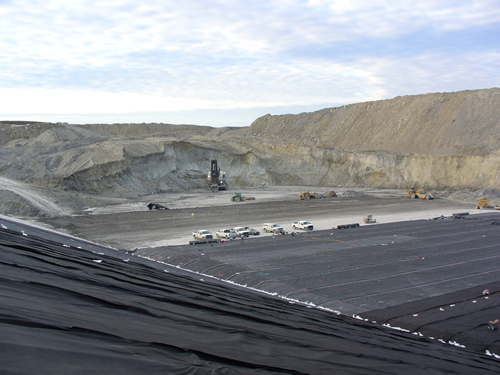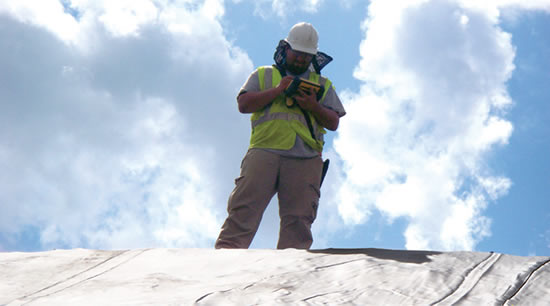


CQA Solutions (CQAS) has built a strong reputation in the geosynthetics field for its approach to quality assurance on geosynthetic installations. This has included pioneering work on the “zero leak” strategy at the Palo Verde Nuclear Generating Station, which is now in its seventh leak-free year. Beyond the company’s impressive site work, CQAS has developed software to improve documentation (SuperTek), published a book on geosynthetic installation, and run training programs for engineering firms, regulators, site owners, and other stakeholders.
In February, CQAS will launch a multi-tier certification platform within its Vendor Management Program. The VMP establishes paths to train up site employees and to recognize and specify staff quality. The new program, which has been carefully developed and used by CQAS personnel for years, fills a void in the field—exactly what is needed, CQAS’ Glen Toepfer notes, if we are to continue providing quality facilities and protecting the industry’s reputation. – Chris Kelsey, Editor
**
GEOSYNTHETICA: Why are you launching this venture?
GLEN TOEPFER: We believe we have a solution owners have been looking for. As owners have come to us for our consulting services, we observed a trend across all geosynthetics market sectors, which is a tendency for site owners to overestimate their asset protection. In some respects, geosynthetic containment site owners are rolling the dice with the current practice. When it comes to the construction of these systems, we trust multi-million dollar projects to unvetted vendors. Part of the reason is the lack of any unified vendor selection system. I’ll give you examples from two different containment vendor markets that I have seen in the past year.
The first example deals with construction quality assurance (CQA) vendors. We’ve seen companies charged the same rate on the same jobsite for a 15-year, highly experienced liner CQA technician and for a “CQA technician” with zero experience who was working as a rock-picking laborer for the earthwork contractor the day before. Is that site owner really getting the service and protection they paid for?
The second example deals with geosynthetics installation vendors. For example, the shale gas play has been huge for years, but it has happened well ahead of regulation and awareness. It has happened well ahead of having enough qualified people in the field to serve the volume of work. As such, a great many geosynthetic installation firms cropped up seemingly overnight. They have no idea what they are doing or even why they are doing it, but they have been getting contracts, because the site owners don’t necessarily understand the containment needs and lack tools to specify quality workmanship on their sites.
With even lower oil prices, these sites have even more severe cost pressures, so site owners are casting the net even wider in search of lower-cost work. And now a new market—coal ash—has opened. These same, less-experienced installation operations are now competing and winning low-cost bids against experienced firms with personnel who have been performing this work for decades.
These new companies may have “experience” listed on their resumes, but their skills and knowledge are inadequate for waste containment projects.
The problem starts long before the first shovel goes into the ground. Site owners simply do not have good information available when it comes to the awarding of bids. All they know is how many years a bidding contractor has been in business and what other jobs they have worked on. Anyone can look good on paper but what do they really know, how do they really perform – these are the answers owners need in order to make an informed decision.
Ultimately, SOQ and resumes are not enough information for proper vendor selection.
GEOSYNTHETICA: What are the specific goals of your vendor management program?
TOEPFER: Our goal is to provide resources that allow owners to “compare apples to apples” when it comes to the vendor selection process and to give owners the tools they need to ensure the project is being constructed to the standards they desire. For instance, skilled trades such as other fields of construction, automotive, electrical are known for promoting quality and safety, for providing a labor force that develops apprentices into journeymen, and for continually moving the needle of professionalism in their industry. This structure provides a solid insurance policy for site owners. The geosynthetics installation industry has bits and pieces of that structure, so we are looking to bridge the gaps. Part of these resources is a certification platform owners can use to evaluate the field skills of their vendors.
GEOSYNTHETICA: How is this certification program to function?
TOEPFER: We are launching it in February 2016 as a comprehensive, online-based CQC and CQA technician qualification program. Through standardized testing, it will help participating site owners, project companies, and their personnel mandate minimum levels of competency for everyone who steps onto a jobsite.
It’s a result of a request we’ve long received, precisely because we have had our own testing and training program. Our technicians have been asked by numerous people if the program might be available to others. We decided to release the test in conjunction with our Vendor Management Program.
The evaluation we provide truly quantifies the field capabilities, knowledge, and skill of individuals directly responsible for the quality of a geosynthetics installation. The platform rates techs on five levels of competency: Entry Level and Levels 1 through 4.
GEOSYNTHETICA: Why five tiers?
TOEPFER: Tiered classification is necessary to ensure proficiency. Experience does not always equal competence. I’ve seen five-year techs who would grade out at a Level 4 and 20-year veterans who would be hard pressed to score a Level 2. This qualification system gives site owners a way to establish clear expectations and enforce vendor compliance.
Importantly, the program is, we believe, the first to feature an entry-level certification. We must ensure a minimum understanding of the importance of geosynthetics in an installation, their functions, and their roles in protecting the environment. That’s a well-recognized need throughout the industry and part of education endeavors, including an emphasis on appropriate use of materials. This program supports that growth.
We also need entry-level workers to understand the tasks required to obtain a quality geosynthetics installation. This is something that has been lacking in our trade for years. It’s common knowledge that even when inexperienced workers are paired with seasoned veterans, the highly experienced people tend to get caught up doing troubleshooting and other management functions, leaving entry level workers on their own in performing tasks where they lack the knowledge and skill required for proper execution. It happens. It will happen. But a certification program can help efficiently bring site workers along so that the overall quality of installations continues to increase.
GEOSYNTHETICA: How long has this been in development?
TOEPFER: It started as an in-house program around 2007, and we have consulted with owners for more than three years as we’ve moved towards making it more widely available. It has been a true team effort for the CQA Solutions team, involving me, Joanna Toepfer, our key staff, and many others.
**
Visit CQA Solutions online for more information on the Vendor Management Program, information on the markets in which CQAS works, videos, and software and training information: www.cqasolutions.co.












